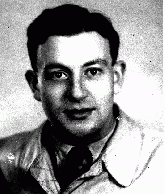
Marthijn Wijnberg
Born: December 23, 1919
Groningen, Netherlands
When Marthijn was 10, his religious Jewish family moved from Groningen to the town of Zwolle. There, his parents ran the only kosher hotel in the region. The Wijnbergs had two other sons and a daughter. All of the children attended Dutch public schools, and four afternoons a week they also went to religious school to study Jewish history, Hebrew and the Bible.
1933-39: Marthijn could play almost any instrument, including piano, saxophone and accordion. Sometimes each of his brothers would pick up an instrument and they would all make an impromptu band. But Marthijn's greatest pleasure was creating pastries and sweets. One day, he built a bridge out of sugar and displayed it at his family's hotel. He attended culinary school, and in 1937 was appointed head pastry chef at a bakery in Rotterdam.
1940-43: Marthjin was drafted into the Dutch army. When war broke out with Germany in May 1940 he served as a sergeant. Four days later, after Holland was defeated, Marthjin returned to Zwolle. His father died in 1941, but the family continued running the hotel until the Germans confiscated it in 1942. The Wijnbergs were relocated to a shack with no bathroom or hot water. When Marthjin's older brother Maurits was sent to a labor camp in the Netherlands, Marthjin insisted on going with him. They worked there from fall 1942 to winter 1943.
On January 31, 1943, Marthijn was deported to Auschwitz, where he perished. He was 23 years old.